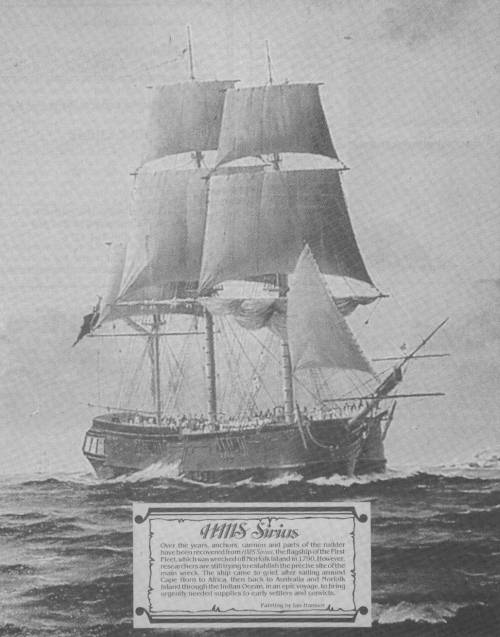- Author
- Barton, Alan
- Subjects
- Ship histories and stories, History - pre-Federation
- Tags
-
- RAN Ships
- None noted.
- Publication
- March 1994 edition of the Naval Historical Review (all rights reserved)
H.M.S. SIRIUS features prominently in our Australian history as she served as Governor Phillip’s flagship, and the guardship to the First Fleet of eleven ships when our nation commenced in 1788.

She was launched in 1780 under the name BERWICK for use in the East India trade. In 1781 the British admiralty purchased her for use as a naval store ship, and she was rated as a “sixth” rate. This meant she was a minor class of warship as the “first-rates” were the best and biggest ships carrying the most guns.
After making two voyages to the West Indies she was laid up but in 1787 she was recommissioned under the command of Captain Phillip and renamed SIRIUS. Phillip had been appointed the first governor of New South Wales on October 12, 1786; he was an excellent choice, being a good and proven leader and was one of the few senior naval officers with experience in agriculture.
Having been damaged by fire, SIRIUS was repaired and her original profile altered. It seems her hull height was raised and her top deck made flush or level fore and aft. Her tonnage was said to be 612 tons or 520 tons. This lower figure may have been the weight of the original BERWICK.
H.M.S. SIRIUS carried four boats and was armed with ten guns, four six-pounders and six carronades. Phillip had ten more guns placed aboard but these were put in the hold and were landed in Sydney to be placed in a fort erected in 1788 on the east side of Sydney Cove.
Her sail rigging was similar to other ships of her type. The foremast and mainmast both carried three square sails. On the rear or mizzen mast it seems there was only one square sail, this mast having a fore and aft sail like the smaller sails near the ship’s bow.
H.M.S. SIRIUS’s hull was well built of teakwood and her bottom was covered in copper. She was painted bright yellow with a broad black band near the waterline. Her extreme length was about 132 feet, height from keel to upper deck 26 feet, loaded draft 17 feet, height of mainmast above the deck 122 feet and her best sailing speed about seven knots.
The First Fleet sailed from Spithead, England on their remarkable voyage to commence a new southern nation on 13th May, 1787. This voyage lasted over eight months and much credit must be given to Phillip that out of more than the 1,300 people carried, only forty died.
On its way to Australia, the fleet visited Santa Cruz, Rio de Janeiro and Cape Town for fresh supplies, water, etc. The fleet arrived at Botany Bay on January 20, 1788 which was the original site for the new colony. However, due to lack of good water and Sydney Harbour being a far better site, the fleet moved to Port Jackson on 26th January.
H.M.S. SIRIUS remained in Port Jackson until the 2nd October, 1788 when she sailed for Capetown for more provisions. In this remarkable voyage she sailed right around the world being the first to do so in the famous sailing ship belt of westerly winds known as “the roaring forties”. On this voyage SIRIUS sailed south of New Zealand and eastwards, past Cape Horn to Capetown arriving approximately 2 January 1789. On her return trip she left Capetown on 20 February, 1789, sailing eastwards again until she reached Port Jackson on May 8, 1789.
Of interest on this voyage, when she was south of Tasmania on April 22 in a storm, her figure-head was washed away and she was badly damaged forward. But for Captain Hunter setting more sails, she would have been blown ashore and wrecked.
SIRIUS again remained in Port Jackson until the 7th March, 1790 when she left on her last voyage which was to Norfolk Island to land marines, convicts and stores.
The island was reached on March 13, unloading at Cascade Bay took place on the 13th and 14th of March after which the passengers walked across the island to the settlement at Sydney Bay. Heavy weather then kept the SIRIUS at sea for four days, but when it improved on the 18th, Captain Hunter lay off Sydney Bay on the south side of Norfolk to land the provisions.




